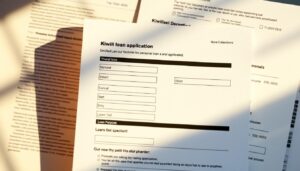Have you ever wondered why so many students choose direct federal loans for their education? These loans offer many benefits that make college more affordable. They are a key part of college financial aid, helping students achieve their dreams.
These loans provide much-needed funds and flexible repayment plans. They help ease the financial stress of going to college. Understanding the role of federal direct loans is crucial for students planning their financial future.
Understanding Federal Student Aid
Federal student aid offers financial help for students going to college. It includes grants, loans, and work-study programs. These help make college affordable for more people.
To get this aid, students need to fill out the FAFSA. This form checks if they need financial help. It opens the door to government loans and other financial options.
What Are Federal Direct Student Loans?
Federal Direct Student Loans are a key part of government student loans. They are for students who are in college or graduate school. These loans are given out by the U.S. Department of Education, making it easier for students to get the money they need.
There are two main types of these loans: subsidized and unsubsidized. Subsidized loans don’t start to build up interest while you’re in school. This can help you keep your debt lower. On the other hand, unsubsidized loans start to build up interest right away. It’s important for borrowers to know this from the start.
It’s important for students to understand the difference between these loans. Knowing which loans to take can help you manage your finances better. This can affect your financial health and how easy it is to pay back your loans.
Direct Federal Loans for Students
Direct federal loans are a key financial help for many college students. They include Direct Subsidized Loans and Direct Unsubsidized Loans. These loans meet different student needs. To get these loans, students must show financial need, be enrolled, and at the right educational level.
Applying early for these federal loan programs is crucial. It greatly increases a student’s chance of getting enough money for school.
Direct federal loans aim to make college more affordable. They have better interest rates and repayment plans than private loans. Knowing the loan eligibility criteria is important.
It helps students get the money they need for school. By learning about these loans, students can make smart choices about their financial future.
Benefits of Federal Direct Student Loans
Federal Direct Student Loans have many benefits for students. They offer lower interest rates than private loans. This makes it easier for students to pay back their loans over time.
They also have flexible repayment plans. These plans help students manage their payments based on their financial situation. This flexibility is very helpful.
Income-driven repayment options are another great feature. These plans adjust payments based on how much you earn. This is especially helpful for new graduates who are just starting their careers.
When times get tough, there are borrower protections. These include deferment and forbearance. They give students a break from payments when they need it most.
These programs make college more affordable for everyone. They help students from all walks of life get the education they need. Federal direct student loans are a key tool for those looking to further their education.
| Feature | Federal Direct Student Loans | Private Loans |
|---|---|---|
| Interest Rates | Lower | Higher |
| Repayment Flexibility | Yes | Limited |
| Income-Driven Repayment | Available | Not Common |
| Borrower Protections | Yes | No |
| Accessibility for College Financial Aid | Broad | Narrow |
Comparison to Other Student Loan Options
Federal direct loans are a top choice for many students. They offer lower interest rates and more stable terms compared to private loans. This is key for students looking to keep their financial load down.
Government student loans also shine in terms of repayment flexibility. They often don’t require a credit check, making them open to more students. Private loans, however, usually check your credit history, which can shut out students without a financial record.
Another plus of federal loans is their repayment protections. They include income-driven plans and forgiveness programs. These help graduates, especially those in tough job markets, manage their debt better. This makes government loans a solid choice for long-term financial health.
Repayment Plans for Federal Direct Loans
Repayment plans for federal direct loans offer flexibility to fit your financial situation. It’s important to know the different options for managing your debt after graduation. The main plans are Standard Repayment, Graduated Repayment, and Income-Driven Repayment.
The Standard Repayment Plan has fixed monthly payments for ten years. It’s good for those with steady incomes. This way, you can pay off your loans faster and save on interest.
The Graduated Repayment Plan starts with lower payments that go up every two years. It’s perfect for those who expect their salary to increase after they start working.
Income-Driven Repayment Plans are great for those with variable incomes or facing financial challenges. Your monthly payments are based on your discretionary income. This helps in tough financial times.
Choosing the right repayment plan is key to avoiding financial stress after college. Knowing the differences in student loan repayment options helps you plan better. This ensures you stay financially stable in the long run.
| Repayment Plan | Characteristics | Ideal Borrower |
|---|---|---|
| Standard Repayment Plan | Fixed payments over 10 years | Individuals with steady income |
| Graduated Repayment Plan | Lower payments that increase every 2 years | Those expecting salary growth |
| Income-Driven Repayment Plans | Payments based on income and family size | Individuals facing financial difficulties |
Loan Forgiveness Programs
Federal Direct Loans can lead to various loan forgiveness programs. This can greatly reduce student debt. The Public Service Loan Forgiveness (PSLF) program is a key option. It helps those working in public service roles by forgiving loans after ten years of qualifying payments.
The Teacher Loan Forgiveness program is another great choice. It’s for teachers in high-need areas. Teachers can get up to $17,500 forgiven, based on their service and subject taught. These programs are vital for those in public service careers, helping them financially in the long run.
| Loan Forgiveness Program | Eligibility Criteria | Forgiveness Amount | Duration of Service |
|---|---|---|---|
| Public Service Loan Forgiveness (PSLF) | Full-time employment in qualifying public service | Remaining balance after 120 qualifying payments | 10 years |
| Teacher Loan Forgiveness | Full-time teaching in low-income schools | Up to $17,500 | 5 consecutive years |
Knowing about these federal loan forgiveness options can help borrowers make smart financial choices. Choosing public service careers can benefit both the community and the individual financially through these programs.
Accessing Additional Student Loan Assistance
Students can find more ways to get financial help beyond government loans. Scholarships and grants are great because you don’t have to pay them back. Many groups, schools, and private companies offer these, each with its own rules and how to apply.
State-funded programs also offer financial help. They give money based on need, grades, or what you’re studying. Knowing what’s available and how to get it is key to getting more money.
There are also special places to help with money matters. Many schools have offices for financial aid. They can help you find all the help you can get. This way, you can use less loans and have a better financial future.
| Type of Assistance | Description | Repayment Requirement |
|---|---|---|
| Government Student Loans | Loans offered by the government to apply towards educational expenses. | Repayment needed, varies by loan type. |
| Scholarships | Financial awards based on merit, financial need, or other criteria. | No repayment required. |
| Grants | Financial aid awarded based on financial need, typically offered by government or institutions. | No repayment required. |
| State-Funded Assistance | Programs providing financial aid based on state residency and specific eligibility requirements. | Varies by program; often no repayment required. |
Common Misconceptions About Federal Direct Loans
Many people think federal direct loans need to be paid back right after graduation. But, students can delay payments with deferment options. This helps students adjust to life after school.
Some believe these loans are only for students who don’t have much money. But, federal direct loans consider many factors, not just income. This means students from different financial situations can get help.
It’s important to learn the truth about federal direct loans. Students should find trustworthy sources to understand their options. Knowing the facts helps students use the financial aid they have wisely.
Conclusion
Understanding the benefits of federal direct student loans is key for students. These loans offer good repayment terms and help students get the education they need. They also provide support to manage debt.
Knowing about federal student aid is very important. Students need to look at different loan options and repayment plans. This helps them make smart choices about their education costs.
At the end, federal direct student loans are a big help for students. They give students the chance to follow their dreams without worrying too much about money. This knowledge helps students plan for a better financial future.





